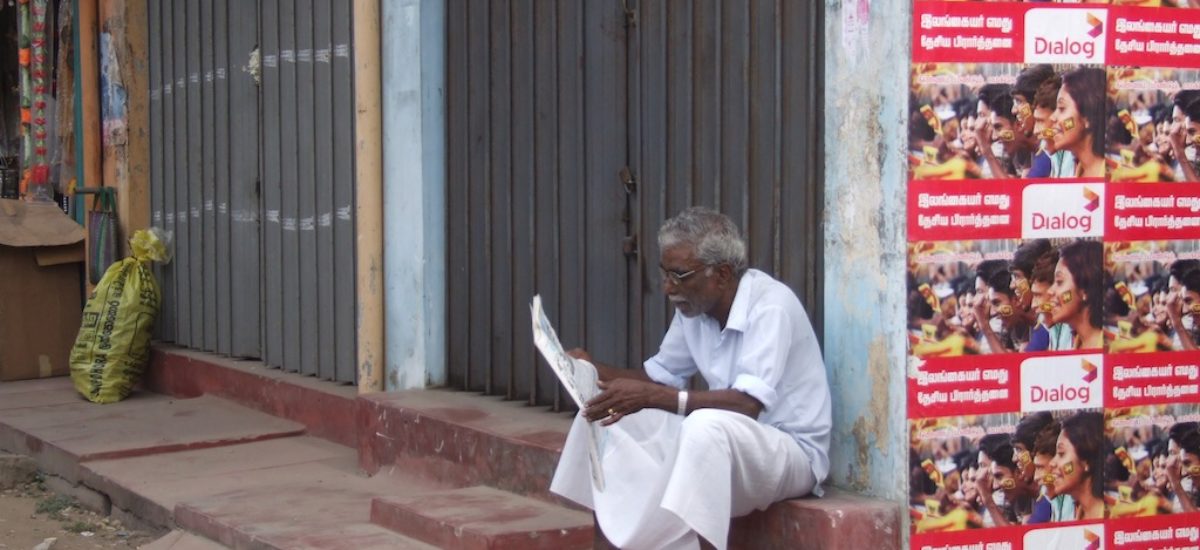Photo courtesy Dushiyanthini‘s Jaffna: Moments of Nostalgia
The roads in Jaffna are long and unending. The day time is dusty and windy. If you listen to the air for a while, you will certainly hear some silent utterances and silent whispers. There are many mysteries hidden inside these silent whispers in Jaffna. There are mysteries about war, blood, devastation, destruction, death and many more. The eyes of its people portray many feelings. No one, as I believe, can dissect or classify those feelings, but their eyes certainly speak volumes.
This is undoubtedly a reawakening period in Jaffna. Jaffna is raising its head. A three-decade long war, as we all know, anaesthetized Jaffna and its people. They heard all the unpleasant stories about firings, killings, devastation, curfews and sanctions on a daily basis. The citizenry was arrested by war. Growth and development were halted. ‘People’ were entrapped in the middle of the hostility. There were serious deficiencies in infrastructure. There was no food; no medicine; no supply of goods; no fuel and no cement. Each and every thing was restricted and prohibited. Life was confined. In this context, many people fled the area. Some fled the city and some fled the country. Their houses were abandoned. Lands were barren. Their properties were enshrouded by jungles. Their relatives, friends and neighbours who could not flee the area due to various reasons, were trapped in the conflict. Some of them were killed. Some survived. Anyhow, all these things are now hidden under the carpet of the ‘past.’ Yes, we can’t change it and that is the undeniable truth.
Yesterday, when I was travelling along the A9 road, this painful past unfolded in my mind. At present, almost all the areas in Jaffna are experiencing a renaissance period. The broken houses are being rebuilt. The old ones are being renovated. Workers are repairing roads and bridges. Lots of construction projects are underway. Schools, shops and banks are now open, and the streets are becoming busier day by day. Most of the roads are repaired and decorated with new nameplates on which the names of the roads are written in all three languages; first in Sinhala and then in Tamil and English. In spite of the heavy military presence in Jaffna peninsula, the lives of civilians are gradually moving on. I don’t call it ‘normalcy’, because the citizenry is still kept under the steady grip of the military, but life keeps moving and changing.
They say that the hostilities are now over and that we can travel from the West to East and South to North. Jaffna has benefitted from this. The ordinary citizens of Jaffna are now forging ahead from the devastation. They are coming out of the social and economic chasm where they lived during the past three decades. The people who have money have started to spend their evenings at the very famous ice cream shop ‘Rio’ where you can find Sri Lanka’s best selection of ice creams. They have started to hang out in Casurina Beach in Karainagar and have some fun on Sundays. People go out to watch movies. Satellite television facilities can be seen many places in the city area. Tamil songs can be heard in shops.
When we look at the surface, the people of Jaffna look nice and fine. There’s nothing to complain about. Tens of thousands of people are coming to the North from the South. As a result, money is flourishing and businesses are growing. Even in the market that is located at the heart of the Jaffna city, I saw many Sinhala people who visited Jaffna from various areas in the South as pilgrims. They buy ‘kotta kilangu’ and the other ‘native’ food and sweets from Jaffna. The Tamil vendors are speaking in Sinhala. The atmosphere is pretty congenial and friendly. “ E kale yaapane demala minissu Sinhala minissunta hariyata selakuwa. Koti thamayi ewa winaasha kale…” (During those early years, the natives of Jaffna treated Sinhalese people so well. The Tigers are the ones who ruined it) I heard someone saying. So now, the Tigers are no more and the equation is different. Therefore, the Sinhalese people can now regain or relinquish whatever they want. All in all, life in Jaffna is still better than what it was a few years ago.
When I visited Nallur Kovil (Tamil temple) in the morning, I experienced the nice and tranquil nature of that holy place. All the Tamils who visit this place behave very carefully and cautiously since they consider it as the pinnacle of their religious places in Sri Lanka. They silently utter their aspirations to their god. It is of course a nice place to visit. But suddenly, a noisy pilgrimage from the South stormed into the Kovil. They were laughing, jabbering and shouting. The serene and tranquil nature of the Kovil was virtually destroyed. But no one, even the Policeman who was kept inside the sacred place, was bothered to explain to them as to what is right and wrong. I left the place with a disgusted feeling.
Still there are people with broken hearts. Still there are many houses where the owners have never returned. When I was travelling in Jaffna on Kankassanthurai Road, I saw how the three-decade old ‘jungles’ covered the abandoned houses. Still there are shattered walls and broken windows in those houses. These shattered walls and destroyed windows are the living witnesses of a buried history. They must have seen the smiles and tears of the people who used to live in those houses some time ago. Are they still alive? Will they return? No one knows. But the remnants and memories of their lives are still alive. Those are the reminiscences of the ‘Old Jaffna’.
Jaffna, for me, is not just a city. It is a reflection of life. That is why I love to visit and revisit Jaffa, again and again.

